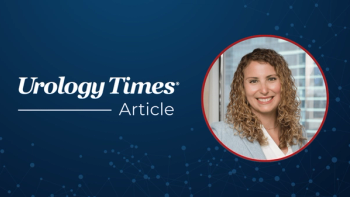
- Vol 49 No 08
- Volume 49
- Issue 08
Industry payments to urologists see sharp decline in 2020
Prostate cancer, BPH, and OAB products are linked with a majority of payments.
Payments from industry—pharmaceutical manufacturers and device companies—to physicians continue to be examined by the federal government, policy makers, and watchdog agencies. Speaker programs appear to be under special scrutiny.1 In July 2020, 1 company agreed to pay $678 million to settle charges of paying more than $100 million to physicians for alleged sham speaker programs.2 In November 2020, the Office of Inspector General (OIG) for the US Department of Health and Human Services issued a Special Fraud Alert regarding industry-sponsored speaker programs.3 That alert reads, in part: “OIG has significant concerns about companies offering or paying remuneration (and HCPs [health care providers] soliciting or receiving remuneration) in connection with speaker programs. Based on our investigations and enforcement actions, this remuneration is often offered or paid to induce (or solicited or received in return for) ordering or prescribing items paid for by Federal health care programs. If the requisite intent is present, both the company and the HCPs may be subject to criminal, civil, and administrative enforcement actions.”
In April 2021, a paper linking Open Payments data to Medicare Part B payment data demonstrated that payments from medical device companies generally exceed that of drug companies and appear to be targeted at surgical specialists who are high billers in the Medicare Part B program.4 The Physician Payments Sunshine Act (Section 6002 of the Affordable Care Act) requires that manufacturers of “covered drugs, devices, biologicals, and medical supplies” report payments and other transfers of value to physicians to the Centers for Medicare and Medicaid Services (CMS), which in turn publishes this information. It also requires that manufacturers and group purchasing organizations (GPOs) report physician (or their family) ownership and investment interests. These requirements stem from a concern that payments to individuals could influence or incentivize behavior and a belief that public reporting might deter inappropriate behaviors or relationships. More than 1 study has shown an association between payments and physician behavior.5,6 On June 30, 2021, CMS released its annual update of Open Payments financial data (calendar year 2020).7 In this article, I will review some information and analysis about the payments to urologists reported under this surveillance program.
In 2020, $9.1 billion in payments or investment value was reported by 1621 unique companies to physicians, teaching hospitals, and other entities. The total amount of general payments to 487,000 individual physician recipients was $2 billion, down from $2.3 billion to 617,000 physicians in 2019. A total of 7922 urologists received a total of $22,861,359 (1.13%) of those general payments from 361 unique manufacturers; total general payments to urologists were down 40% from the previous year. The largest single payment to a urologist was $523,338.17, and the average payment to a urologist in 2020 was $211.17 (up 16%); average and total payments to urologists have been increasing an average of about 7% per year over the last 5 years. In 2020, 35 urologists each received more than $100,000 (average, $271,000 in this subgroup) and collectively represented 42% of all payments to urologists (Figures 1 and 2). The maximum number of payments to a single urologist in 2020 was 501 (almost all associated with a single medical device totaling over $500,000). As in past years, most of the 2020 payments to urologists came in the form of cash (Table 1), and were compensation for consulting fees, services other than consulting, food and beverage, and royalty or license. Services other than consulting (this category includes speaker programs) dropped sharply in 2020 (about $10 million or 60%) from the previous year, possibly reflecting the impact of the COVID-19 pandemic on meetings and speaker programs.
CMS requires manufacturers and GPOs to associate a general payment with a drug, biologic, device, or medical supply where appropriate (many payments are uncategorized). General payments associated with devices comprised the largest category—$12,686,907.22 from 138 manufacturers to over 6000 urologists—over half of all general payments. Four products (UroLift, Cook medical extractors, da Vinci Surgical System, and Titan) accounted for over half of all payments. Payments associated with drugs and biologics totaled about $5.3 million, down 50% from the previous year; 4 prostate cancer drugs (enzalutamide [Xtandi], apalutamide [Erleada], darolutamide [Nubeqa], and sipuleucel-T [Provenge]) accounted for over half of 2020 total payments in this category.
The Open Payments program tracks payments associated with ownership interest in 2 ways. First, some of the general payments to physicians are categorized as “Current or prospective ownership or investment interest.” In 2020, $807,964 in ownership or investment interest was paid from 9 entities to 51 urologists. Most of these payments appear to come from limited liability companies. The largest single ownership payment to a urologist was $235,000 and was uncategorized.
The second way that payments related to physician ownership are reported is by the “value of interest,” defined as “the current cumulative value of ownership or investment interest held by the physician (or the physician’s immediate family members) in the Applicable Manufacturer or GPO as of the most recent feasible valuation date preceding the reporting date.” A total of $1.12 billion of value was reported in 2020 for all physicians, and $36 million (3%) of that was attributed to 445 urologists from 15 entities. Most of the dollars reported of this type are from a single entity totaling $30 million in value of interest (more than double the 2019 value for that entity) and distributed among 254 individual urologists; the value of interest for each urologist in that entity ranges from $3.5 million to $16,000 and was primarily held as common stock.
The final type of payments in the Open Payments program are payments associated with research, almost all of which are received by teaching hospitals, not individual physicians. Payments to physicians for 2020 total about $73 million, $467,000 (0.56%) of which went to 84 urologists from 20 manufacturers in an average amount of $1980. The maximum amount of research payments reported to a single urologist in 2020 was $122,423.
Bottom line: General payments from manufacturers to urologists in 2020 reported to and by CMS under the Sunshine Act are sharply down from the previous year, represent a small fraction of general payments to all physicians, and average $211 per urologist. Most of these payments are from device manufacturers, and payments are concentrated in just a handful of individual companies, drugs, devices, physician recipients, and disease states. Prostate cancer (drugs), benign prostatic hyperplasia (devices),and overactive bladder (drugs) continue to be associated with most of the collective payments in the specialty. The reported value of cumulative interest/stock of urologists rose sharply from about $21 million in 2019 to more than $36 million in 2020. Research payments to urologists in 2019 were negligible. The majority of urologists appear in the payment data, but payments are generally small. •
References
1. Adashi EY, Cohen IG. Industry-sponsored speaker programs—end of the line? JAMA. 2021;325(18):1835-1836. doi:10.1001/jama.2020.26580
2. Acting Manhattan U.S. Attorney announces $678 million settlement of fraud lawsuit against Novartis Pharmaceuticals for operating sham speaker programs through which it paid over $100 million to doctors to unlawfully induce them to prescribe Novartis drugs. News release. The United States Attorney’s Office, Southern District of New York. July 1, 2020. Accessed July 12, 2021. https://bit.ly/3wCD1hJ
3. Special fraud alert: speaker programs. Department of Health and Human Services Office of the Inspector General. November 16, 2020. Accessed July 12, 2021. https://bit.ly/3wBqfQJ
4. Bergman A, Grennan M, Swanson A. Medical device firm payments to physicians exceed what drug companies pay physicians, target surgical specialists. Health Aff (Millwood). 2021;40(4)603-612. doi:10.1377/hlthaff.2020.01785
5. Annapureddy AR, Henien S, Wang Y, et al. Association between industry payments to physicians and device selection in ICD implantation. JAMA. 2020;324(17):1755-1764. doi:10.1001/jama.2020.17436
6. Mitchell AP, Trivedi NU, Gennarelli RL, et al. Are financial payments from the pharmaceutical industry associated with physician prescribing? A systematic review. Ann Intern Med. 2021;174(3):353-361. doi:10.7326/M20-5665
7. What is open payments? Centers for Medicare & Medicaid Services. Updated June 30, 2021. Accessed July 12, 2021. https://go.cms.gov/2VKzcu9
All tables and figures are adapted from an analysis of open payments data downloaded from https://www.cms.gov/openpayments/explore-the-data/dataset-downloads by the author, Robert Dowling, MD.
Articles in this issue
over 4 years ago
COVID-19 and men’s health: What we know so farover 4 years ago
Nocturia: Mind vs medicationover 4 years ago
Urology Times Money Matters: Estate Planning mistakes to avoidNewsletter
Stay current with the latest urology news and practice-changing insights — sign up now for the essential updates every urologist needs.


















